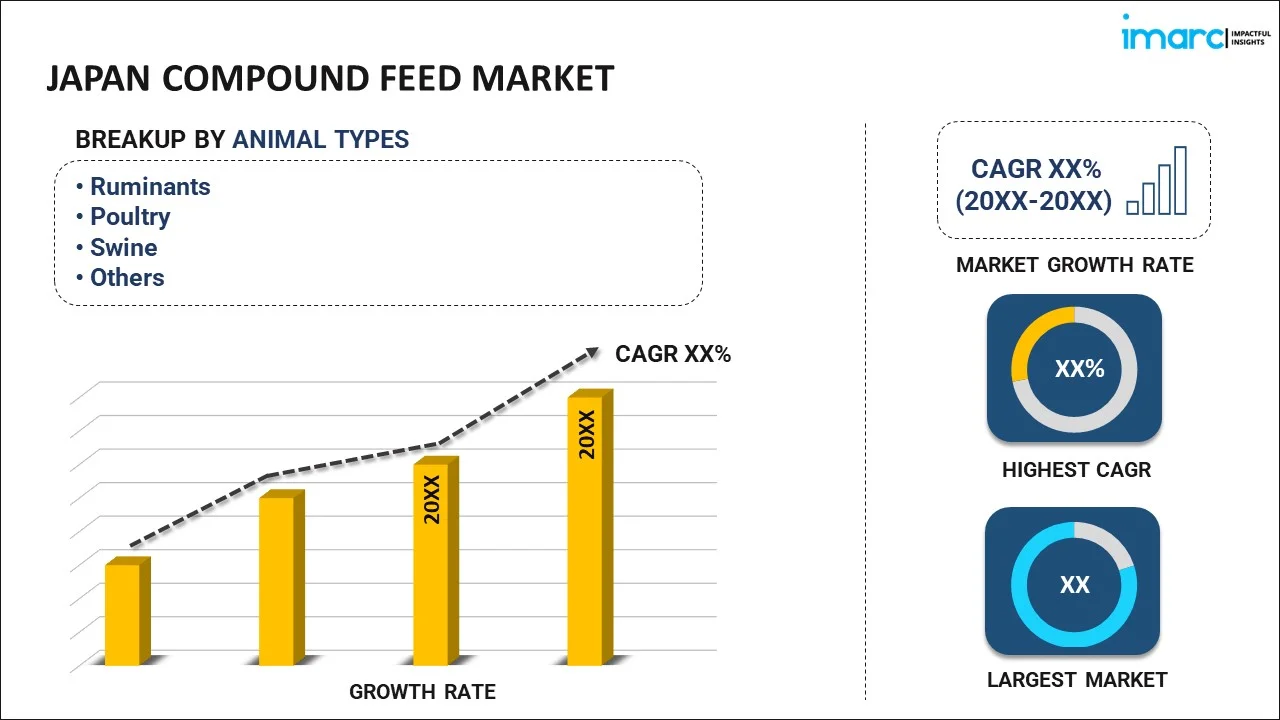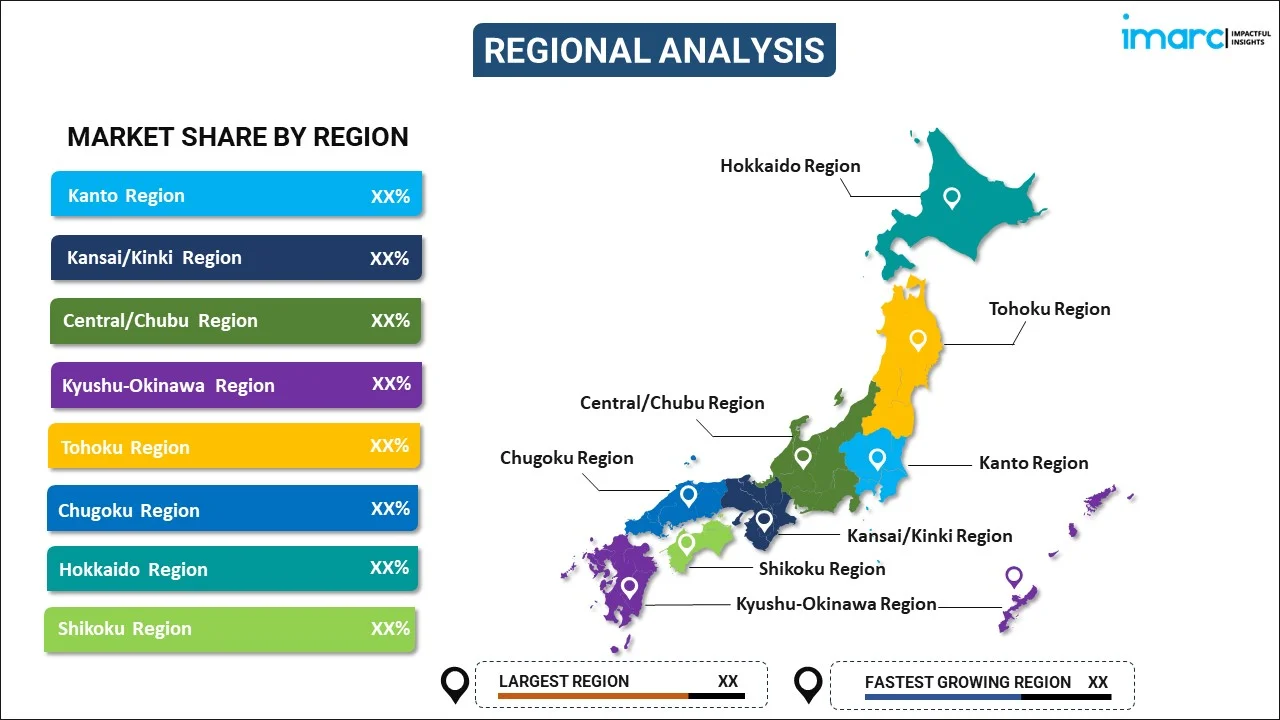
Japan Compound Feed Market Report by Animal Type (Ruminants, Poultry, Swine, Aquaculture, and Others), Ingredient (Cereals, Cakes and Meals, By-Products, Supplements), and Region 2025-2033
Market Overview:
Japan compound feed market size reached USD 12.4 Billion in 2024. Looking forward, IMARC Group expects the market to reach USD 17.0 Billion by 2033, exhibiting a growth rate (CAGR) of 3.3% during 2025-2033. The escalating prevalence of disease outbreaks in the livestock industry, which can disrupt production and lead to increased demand for specialized feeds that promote animal health and disease resistance, is primarily driving the market.
|
Report Attribute
|
Key Statistics
|
|---|---|
|
Base Year
|
2024
|
|
Forecast Years
|
2025-2033
|
|
Historical Years
|
2019-2024
|
| Market Size in 2024 | USD 12.4 Billion |
| Market Forecast in 2033 | USD 17.0 Billion |
| Market Growth Rate 2025-2033 | 3.3% |
Compound feed, also known as complete feed or pelleted feed, is a nutritionally balanced mixture of various ingredients formulated to meet the dietary needs of livestock and poultry. It is a critical component of modern animal husbandry and plays a crucial role in optimizing animal health, growth, and productivity. Typically, compound feed consists of a blend of grains, protein sources (such as soybean meal or fish meal), vitamins, minerals, and sometimes additives like antibiotics or growth promoters. The exact composition varies depending on the specific requirements of the animal species and their stage of development. For instance, feed for broiler chickens will differ from that for dairy cows or swine. The manufacturing process involves grinding, mixing, and pelleting the ingredients to create a uniform and easily digestible product. Compound feed offers several advantages, including precise nutrient control, reduced waste, and convenient feeding management.
Japan Compound Feed Market Trends:
The compound feed market in Japan is driven by a multitude of factors, notably, the burgeoning demand for meat and dairy products, which, in turn, necessitates a consistent supply of high-quality feed for livestock, poultry, and aquaculture. Additionally, the increasing awareness regarding animal health and nutritional requirements acts as a catalyst, propelling the need for balanced and nutritious feed. Concurrently, the surge in industrial livestock production to meet the ever-growing food demand significantly fuels the compound feed market in Japan. Another pivotal driver is technological advancements in feed production processes, which facilitate enhanced scalability and cost efficiency, thus bolstering the regional market growth. Moreover, stringent regulatory frameworks that focus on food safety and animal welfare are inducing manufacturers to produce superior quality compound feed. This, in turn, is also creating a positive outlook for the market. In addition to this, the escalating prominence of sustainable farming practices underlines the importance of optimizing agricultural by-products, a factor instrumental in promoting compound feed utilization. Furthermore, the advent of customized feed solutions, tailored to cater to the distinct nutritional needs of different animal species and developmental stages, is expected to drive the compound feed market in Japan during the forecast period.
Japan Compound Feed Market Segmentation:
IMARC Group provides an analysis of the key trends in each segment of the market, along with forecasts at the country level for 2025-2033. Our report has categorized the market based on animal type and ingredient.
Animal Type Insights:

- Ruminants
- Poultry
- Swine
- Aquaculture
- Others
The report has provided a detailed breakup and analysis of the market based on the animal type. This includes ruminants, poultry, swine, aquaculture, and others.
Ingredient Insights:
- Cereals
- Cakes and Meals
- By-Products
- Supplements
A detailed breakup and analysis of the market based on the ingredient have also been provided in the report. This includes cereals, cakes and meals, by-products, and supplements.
Regional Insights:

- Kanto Region
- Kansai/Kinki Region
- Central/ Chubu Region
- Kyushu-Okinawa Region
- Tohoku Region
- Chugoku Region
- Hokkaido Region
- Shikoku Region
The report has also provided a comprehensive analysis of all the major regional markets, which include Kanto Region, Kansai/Kinki Region, Central/ Chubu Region, Kyushu-Okinawa Region, Tohoku Region, Chugoku Region, Hokkaido Region, and Shikoku Region.
Competitive Landscape:
The market research report has also provided a comprehensive analysis of the competitive landscape in the market. Competitive analysis such as market structure, key player positioning, top winning strategies, competitive dashboard, and company evaluation quadrant has been covered in the report. Also, detailed profiles of all major companies have been provided.
Japan Compound Feed Market Report Coverage:
| Report Features | Details |
|---|---|
| Base Year of the Analysis | 2024 |
| Historical Period | 2019-2024 |
| Forecast Period | 2025-2033 |
| Units | Billion USD |
| Scope of the Report | Exploration of Historical and Forecast Trends, Industry Catalysts and Challenges, Segment-Wise Historical and Predictive Market Assessment:
|
| Animal Types Covered | Ruminants, Poultry, Swine, Aquaculture, Others |
| Ingredients Covered | Cereals, Cakes and Meals, By-Products, Supplements |
| Regions Covered | Kanto Region, Kansai/Kinki Region, Central/ Chubu Region, Kyushu-Okinawa Region, Tohoku Region, Chugoku Region, Hokkaido Region, Shikoku Region |
| Customization Scope | 10% Free Customization |
| Post-Sale Analyst Support | 10-12 Weeks |
| Delivery Format | PDF and Excel through Email (We can also provide the editable version of the report in PPT/Word format on special request) |
Key Questions Answered in This Report:
- How has the Japan compound feed market performed so far and how will it perform in the coming years?
- What has been the impact of COVID-19 on the Japan compound feed market?
- What is the breakup of the Japan compound feed market on the basis of animal type?
- What is the breakup of the Japan compound feed market on the basis of ingredient?
- What are the various stages in the value chain of the Japan compound feed market?
- What are the key driving factors and challenges in the Japan compound feed?
- What is the structure of the Japan compound feed market and who are the key players?
- What is the degree of competition in the Japan compound feed market?
Key Benefits for Stakeholders:
- IMARC’s industry report offers a comprehensive quantitative analysis of various market segments, historical and current market trends, market forecasts, and dynamics of the Japan compound feed market from 2019-2033.
- The research report provides the latest information on the market drivers, challenges, and opportunities in the Japan compound feed market.
- Porter's five forces analysis assist stakeholders in assessing the impact of new entrants, competitive rivalry, supplier power, buyer power, and the threat of substitution. It helps stakeholders to analyze the level of competition within the Japan compound feed industry and its attractiveness.
- Competitive landscape allows stakeholders to understand their competitive environment and provides an insight into the current positions of key players in the market.
Need more help?
- Speak to our experienced analysts for insights on the current market scenarios.
- Include additional segments and countries to customize the report as per your requirement.
- Gain an unparalleled competitive advantage in your domain by understanding how to utilize the report and positively impacting your operations and revenue.
- For further assistance, please connect with our analysts.
 Inquire Before Buying
Inquire Before Buying
 Speak to an Analyst
Speak to an Analyst
 Request Brochure
Request Brochure
 Request Customization
Request Customization




.webp)




.webp)












